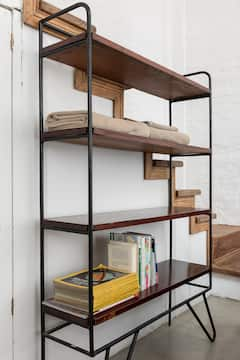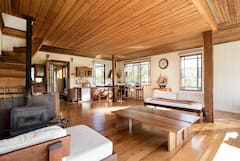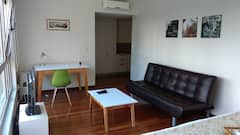Diego Maradona, Leo Messi, football – these are some of the things that might come to mind when you mention Argentina or Buenos Aires. Buenos Aires is the capital of the Republic of Argentina in South America, and it is a very big and cosmopolitan city. It is famous for its European atmosphere, tango, and lively nightlife. There is lot of scope for a traveller to have a gala time when visiting Buenos Aires. Be it food or places to see, there is something for everyone. Here are some of the best things to enjoy on a trip to Buenos Aires:
1. Day trip to Eye of the Tigre, Tiger Delta (from USD 85.0)

Although the name of the place has “tiger” in it, there aren’t any tigers that you are going to see. This place is flocked by locals as a weekend hangout. There are lots of eating options near the riverside. The Tiger Delta is accessible by boats as well as by train, and it takes about an hour from the city centre. The water might appear muddy and thus not very inviting for swimming., but the boat trip is recommended for tourists to see how people here live on the islands and shop using the river taxis. You could arrange a guided tour to the island as well.
A guided tour will let you visit the residential neighborhoods admire the unique architecture of elegant homes, see the Presidential Residence (Quinta de Olivos) and enjoy a boat ride through the Tigre Delta and its islands.
From Buenos Aires: Tigre Delta Tour with Boat Ride
Duration: 5.0 hour
2. Eat a media luna (from USD 116.0)

A media luna is an Argentinean croissant. It is shaped like a half-moon (media luna roughly translates to half-moon). It is bit smaller, and also quite sweeter, than its French counterpart. It gives you a good experience to try local eats and enjoy an authentic taste of Argentina.
If this whets your appetite and you are keen to try out more. Sign up for a Food Walking Tour!
Buenos Aires Food Walking Tour in Recoleta
Duration: 3 hours
3. Teatro Colon, Buenos Aires (From 67 USD)

Teatro Colon is Spanish for Columbus Theatre. This is the main opera house in Buenos Aires, and it was ranked as the 3rd best in the world by National Geographic – a great achievement! Acoustically, this opera house is said to be one of the top 5 venues for concerts globally. It is a gorgeous-looking theatre having an “antique” vintage feel to it. You could try the guided tour around this opera house; it is highly recommended and will help you appreciate this place more. This is surely a must-visit when you are in Buenos Aires, and an experience you must not miss.
Combine a walking tour of Buenos Aires with visits to the Museum of Latin American Art of Buenos Aires and the Colón Theater during this morning excursion!
Buenos Aires Walking Tour Including Colon Theater and MALBA
Price: From 67 USD
Duration: Flexible depending on which options you choose.
Includes: Professional guide and Entrance Fees
You might be interested in these Airbnbs!
4. La Recoleta Cemetery

This cemetery is located in the Recoleta neighbourhood of Buenos Aires, Argentina. Now why is a cemetery on a “Things to Do in Buenos Aires” list? Funnily, this is one of the most popular attractions among tourists in Buenos Aires. It is so popular because it houses the graves of famous people, such as former presidents of Argentina, Eva Peron, and a granddaughter of Napoleon, to name a few. This cemetery was hailed as one of the best of its kind by the BBC in 2011 and was listed among the most beautiful cemeteries in the world by CNN. This site has 4,691 vaults and most of them have been designated as National Monuments. It is advisable to use the map once you enter the cemetery, as it is quite easy to get lost! The cemetery is open every day from 7 am to 5.30 pm.
5. Puerto Madero Waterfront

Puerto Madero Waterfront is set on the banks of the Rio de la Plata. It is one of the latest architectural wonders of Buenos Aires, up-scaled from a neglected piece of land to a place of interest. You will find sleek high-rise buildings, coiffed parks, and pretty sidewalks. There are loads of shopping options, restaurants, and, of course, nightclubs in this area.
6. Tierra Santa

Have you ever heard of a religious theme park? Sounds different! This is what Tierra Santa is. Open only on Fridays, Saturdays, and Sundays, this theme park revolves around the different stages in the life of Jesus Christ, right from His birth till He was crucified and resurrected. It is aimed at children, mainly to teach them about Christ. Adults might not enjoy it as much, and non-Christians may not fully appreciate the park. Nonetheless, it can be a great place to take kids if you want them to learn more about Christianity.
7. Buenos Aires Ecological Reserve

This ecological reserve is also known as Costanera Sur Ecological Reserve or Reserva Ecológica de Buenos Aires. This is a huge area of low land, on the riverbank of the Rio de la Planta in Puerto Madera. This reserve is an ideal escape from the big city, especially loved by locals. Here, you can find a lot of trails up to the river that offer plenty of scope for birdwatching and cycling. If you are a nature-lover you’re bound to enjoy Buenos Aires Ecological Reserve!.
8. Eat dulce de leche

When in Rome, be a Roman, so also eat like a Roman! So, when you are in Argentina, indulge to the maximum on the nation’s favourite dessert, the dulce de leche. It is made from milk, and, although variations exist in other countries, different countries have different recipes. In Buenos Aires, you will find dulce de leche in many items – ice cream, cakes, cookies, crepes, and churros, to name just a few! It can be an overload for some, but it is a favourite ingredient in Argentina. You can find some good dulce de leche sweets in almost every corner of Buenos Aires. A recommendation is the ice cream from Haledos Jauja; they home-deliver, even in the dead of the night, so indulge your sweet cravings no matter what the hour and enjoy!
Do also try the volcán de dulce de leche, a crisp, warm cake topped with generous amounts of sweet caramel at Cluny in Palermo Soho, Buenos Aires.
9. Tango at a milonga! (From 135 USD)

Tango, as you may know, is a form of partner dance. It originated somewhere around the border between Uruguay and Argentina. It is a part of the cultural heritage of Argentina, and so when you arrive in Buenos Aires, you will be thrilled to find tango is present everywhere! For locals, tango is not a hobby; it is a lifestyle. If you are interested in dancing, you might want to learn a thing or two about tango. You will find milongas, groups where you can shake a leg as an amateur, with a lot of people like you. If you wish to take part in a milonga you must head to the favourite ones in town. Milonga Parakultural at Palermo Soho is particularly recommended.
Open on Mondays, Tuesdays, or Fridays, it is better to arrive earlier than the starting time of 7 pm. However, the best things happen later on in the evening, so hang in there! There is another good place, called Cafe Vinilo, in Ciudad de Buenos Aires, which is not very expensive. Or, you could head to San Telmo or La Boca where tangueros perform for you on stage.
Want something a little less spontaneous, yet without missing out on any fun? This Milonga Tour will let you practice some moves before you head out and tango!
Milonga Tour in Buenos Aires
Price: From 135 USD
Duration: Approximately 4 hours
Includes: Admission tickets to both milongas
Bilingual driver/guide
Hotel pickup and drop-off
Live entertainment
Group tango class
10. Watch a polo match at Palermo (From 180 USD)

Watching a live polo match is, indeed, a thing of joy if you are interested in polo, especially when you are in Buenos Aires. Book a trip to watch the match and you can escape to the countryside, meet Argentinean polo players, visit a polo club, and get to eat tasty food and drinks as well as watching the match. The tour packages start from 150 USD per person and transportation is included. Alternately, you could book tickets to the match online and arrange everything on your own. So, why not enjoy a trip at your own leisure?
Polo Under the Stars
Price: From 180 USD
Duration: 5 hours
Includes: Watch a 4 chukkas polo match played by professional players.
Enjoy this experience at the only illuminated professional field in Argentina.
Complete your evening with regional Empanadas and best Argentine wine.
Learn the fundamentals of the sport of kings.
11. Ride an old fashioned subway

The subway is part and parcel of the daily life of an average Argentinean, so why not try to go on a ride to get a feel of what it is to be an average local. The subway in Buenos Aires is said to be much easier to navigate than the complex bus system. You could choose to use the map or the app to help use the subway. You can buy a paper ticket or use an electronic ticket, which is rechargeable, called the Sube card. A train journey costs 5 ARS (approximately 0.35 USD) for a regular ticket, or 4.50 ARS (approximately 0.30 USD) when you use the Sube card. Note that every year on January 12th, the “No Pants Subway Ride” fest is on. Yes, you read that right – passengers travel without pants! So, if you are not game for this, avoid travelling to Buenos Aires during this time!
12. Meet gauchos at Feria de Mataderos

Mataderos is a neighbourhood in Buenos Aires. A gaucho is a term used to refer a person from the countryside, someone like a north-american cowboy. Gauchos are a symbol of pride for Argentina and Uruguay. They are greatly admired and looked up to as legends, featuring in lots of folklore. Feria de Mataderos is a weekly folk fair, and surely a must on your things-to-do list. It is held on Sundays during the months of March to December, while in January and February, it is held on Saturdays. It is truly a celebration of country life, and gives you a good change from the usual modern barrios. The main event at this Feria de Mataderos is called the sortija, wherein the gaucho horsemen literally stand up on the horses’ saddles, much like cowboys, and gallop down the street! And, there is song and dance routine as well for couples. As you walk down along the Avenida de los Corrales, you might come across some tango dancing!
13. Watch the Mothers of Plaza de Mayo

The Mothers of Plaza de Mayo is a group comprising Argentinean mothers whose children disappeared between 1976 and 1983 during the military dictatorship. The Plaza de Mayo is the heart of Buenos Aires’ city centre, and it is here that the mothers come and protest in the most non-violent way possible. The protest happens up to today, seeking answers for the disappearance of the children of all these protesting mothers. Every Thursday at 3.30 pm, you can see them come together.
14. Paseo del Rosedal

Rose Garden Walk, or Paseo del Rosedal, is a wonderful place to visit when you feel too carried away by the fast city life of Buenos Aires. Paseo del Rosedal is a heaven within a city, giving you a Zen-like feeling when you arrive here. The park is beautiful, charming, and relaxing; all you shutterbugs better take a fully-charged camera when you head to this garden. Apart from this, you could take a stroll here and also roller skate, so kids will love it here.
15. Coleccion de Arte Amalia Lacroze de Fortabat

This is a fine arts museum located in Buenos Aires, Argentina. It houses some of the most-outstanding works of art in Buenos Aires. It is recommended as a must-visit place for any tourist visiting the city. An entry fee of 70 ARS (approximately 5 USD) is necessary to be paid at the door. The museum is open from Tuesday to Sunday from noon to 8 pm.
16. Evening stroll down Avenida Corrientes

This avenue is one of the main streets in Buenos Aires; you can probably see some tango action going on live! This street is also referred to as the “Street that never sleeps”. The street stretches about 8-9 kilometres (5-5.6 miles) from Puerto Madero to Chacarita. You will find a large number of theatres in this place, and tango is a pretty common affair here. If you think this place is stuck in the past, well, think again. It has much to offer a modern day woman or man. Take food for example: some really tasty pizzas in town are found here in Corrientes. Some other things that you can shop for here are records, CDs, custom-printed T shirts, etc.
17. Obelisco de Buenos Aires

The Obelisk of Buenos Aires / Obelisco de Buenos Aires is the national monument and icon of the city. It is located at the Plaza de la Republica, at the intersection of Avenida Corrientes and 9 de Julio. This monument resembles a giant pencil, an uncomplicated piece of architecture. This obelisk forms the central point for various rallies, public gatherings, political demonstrations, candlelight marches, and even to celebrate sporting victories.
18. Visit Plaza Dorrego, San Telmo on a Sunday

Plaza Dorrego, or Dorrego Square, is a square located in the heart of San Telmo in Buenos Aires. Visiting Plaza Dorrego on a Sunday is definitely an activity you must do as a tourist visiting Buenos Aires. When the rest of the city is relaxing at home on a Sunday, Defensa Street is almost closed for traffic. It turns into a market! Around 8,000 people come together to buy and sell, locals and tourists alike. What do they sell? Many things, including antique goods and knick-knacks. You could also catch a tango performance, chill at an old café sipping your coffee or a beer, or just watch the chaos! It is also called the Plaza Dorrego Sunday Market, or the Feria de San Telmo.
19. Barrio Chino, Belgrano

You may have guessed from the name what this place is – Chinatown of Buenos Aires. As with any other similar Chinatowns in the Americas, you can expect to see eateries, Buddhist temples, and grocery stores. This place is the centre of the Chinese community in Argentina. Chinese New Year is celebrated with much pomp and splendour by the migrant Chinese population, very similar to their mainland compatriots. So, if you have a liking for Chinese food and culture, this place is a must-visit.
20. Edificio Kavanagh

The Kavanagh Building / Edificio Kavanagh is an Art-Deco skyscraper, another architectural wonder in Buenos Aires. At one point in time, it was the highest skyscraper in Latin America. The building gives you a whiff of what it was like in a particular era. Although several other buildings have risen higher than the Kavanagh Building, it still exudes its own special charm.
21. Iglesia de San Ignacio

This is the St Ignatius Church in Buenos Aires, a Roman Catholic church located in the Illuminated Block of the Montserrat neighbourhood. It was built in 1675, with later additions, and is the oldest church in Buenos Aires. It was also declared as a National Historic Monument.
22. Museo Nacionale de Bellas Artes

The Museo Nacionale de Bellas Artes is also called the National Museum of Fine Arts in English. There are different exhibitions at various points during the year, so do check before heading there as you might not want to miss your favourite artist being showcased. Admission is free for all. The museum is closed on Mondays and open throughout the rest of the week at specific times – please check before going.
23. Uruguay Corvette Museum Ship

ARA Uruguay is a small ship referred to as a corvette. It is permanently docked at Puerto Madero. This ship is open for public viewing. The boat was built in 1874 and it was initially used as a rescue ship for rescuing survivors who were stranded in the freezing Antarctic region. The mission was successful and all those aboard returned safely to Argentina. A visit to this ship is recommended for anyone who is interested in boats and history. An admission fee of 2 ARS is charged (approximately 0.15 USD).
24. Museum of the Argentine Automobile Club

This museum is located at the centre of the city of Buenos Aires. This museum has in its possession an amazing collection of vintage cars, sport cars, and even something like a Popemobile (the car driven by the Pope)! Some of the popular car models on display include a 1902 Schacht, an 1892 Daimler, a 1903 Peugeot, a 1908 Ford, a 1904 Darracq, and a 1911 Renault. The museum is open from 10 am to 5 pm every day, and it is closed on weekends and public holidays. Admission is free. There are guided tours available upon request.
25. La Boca

La Boca is yet another barrio, or neighbourhood, in Buenos Aires. This neighbourhood has many Italian settlers and still retains its strong European flavour. It has a few popular tourist attractions such as Caminito, the colourful artists’ street, and La Bombanera, the football stadium. This place can be a bit shady after evening hours, and there isn’t as much nightlife as you may expect.
26. Piramide de Mayo, Montserrat

Also referred to as the May Pyramid, this is the first patriotic monument of Buenos Aires, thus making it the first national monument of the city. It is located at the centre of Plaza de Mayo. It was built to commemorate the first anniversary of the May Revolution, revolutionary social and political events that occurred in the city in the early years of the 19th century.
27. Congressional Plaza

This is a public park facing the Argentine Congress, the legislative branch of the Argentinean government. It is a part of a 3-hectare (7.4-acre) space, which comprises 3 adjoining plazas at the other end of the Congress building. You can find the Kilometre Zero monument here too. There is another structure, called Monument of the Two Congresses, accompanied by The Thinker. The Monument of the Two Congresses celebrates the Declaration of Independence in the year 1816.
28. Torre Monumental

The Torre Monumental was formerly called Torre de los Ingleses, or Tower of the English. This monument is located in the neighbourhood of Retiro, Buenos Aires. It was a gift from the local British community to the city to commemorate the centenary year of the May Revolution. The tower is built in the Palladian style and is decorated by symbols of the British Empire.
29. Palacio Paz, or Paz Palace

Palacio Paz is located in the centre of the city of Buenos Aires, opposite Plaza San Martin. The palace is a huge building whose architecture has been inspired by several French palaces, and it can be said to be one of the best examples of French Architecture in Argentina. Paz Palace was formerly a mansion in Buenos Aires, which housed the Military Officers’ Association, a social club said to be maintained by the Argentinean military. Palacio Paz is currently the headquarters of the Military Circle in Buenos Aires. It is one of just a few splendid French buildings that are open for public viewing. There are guided tours, which are the only means to have glimpse of the splendour and marvel at the architecture. Guided tours in Spanish are available from Wednesday to Saturday at 11 am, and Tuesday until Friday at 3 pm. Guided tours in English are available only on Thursdays at 3.30 pm.
30. Galileo Galilei Planetarium

The planetarium is commonly called Planetario in Buenos Aires. It is located in the Palermo district or barrio of the city. One of the popular and fascinating exhibits includes the Lunar Rock that was brought back to earth from the Apollo XI mission and was gifted to the planetarium by Richard Nixon. There are a lot of free activities for children that will equally enthral adults. The planetarium is closed on Mondays, and open for the rest of the week from 9.30 am until 5 pm. During the weekends it is open from 11.30 am until 7 pm.
Pack your bags for Buenos Aires!
The city of Buenos Aires is a vibrant city to say the least, along with the fact that you get to eat lip-smacking food and a variety of cuisine. A city with a good mix of history and modernity is a perfect traveller’s fix, in short, Buenos Aires is a perfect destination with a good mix of tourist spots to visit. Get your trip booked!
History
Get Trip101 in your inbox
Unsubscribe in one click. See our Privacy Policy for more information on how we use your data
























Create an account to